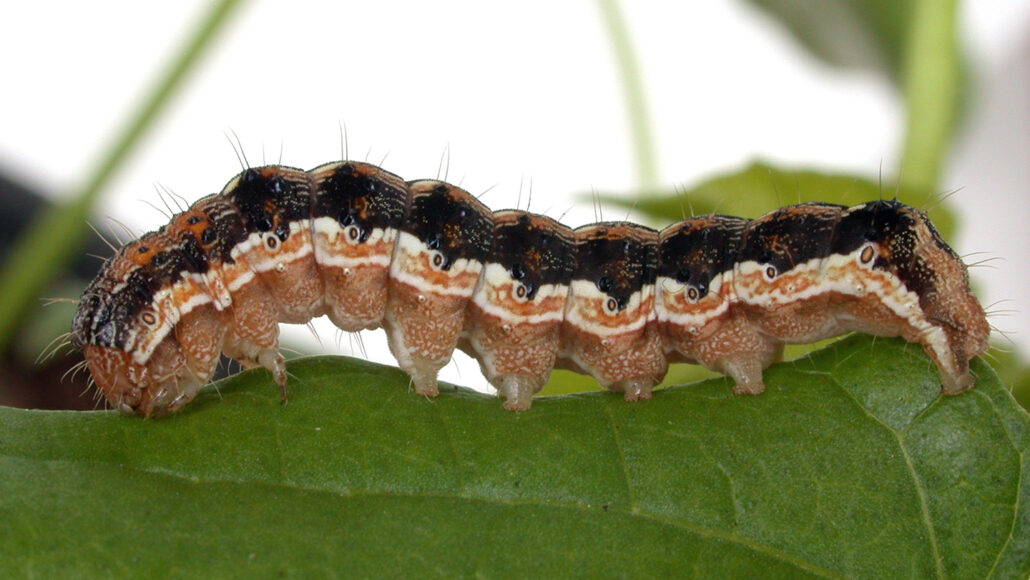Infected caterpillars become zombies that climb to their deaths
A virus that tampers with genes involved in vision makes the insects obsessed with sunlight

Caterpillars of the cotton bollworm moth, such as the one seen here, climb skyward when infected with a virus that boosts the insects’ attraction to sunlight.
David McClenaghan/CSIRO (CC BY 3.0)
By Jake Buehler
Some viruses doom caterpillars to a horror movie demise. These viruses force caterpillars to climb to the tops of plants, where they die. There, scavengers will devour the caterpillars’ virus-ridden corpses. But just how such viruses march caterpillars to their deaths has been a mystery. Now, it seems that at least one zombifying virus tampers with the genes that control caterpillars’ sight. This sends the insects on a doomed quest for maximum sunlight.
Researchers shared that new discovery online March 8 in Molecular Ecology.
The virus in question is called HearNPV. It is a type of baculovirus (BAK-yoo-loh-VY-russ). Although they can infect more than 800 insect species, these viruses mostly target the caterpillars of moths and butterflies. Once infected, a caterpillar will feel compelled to climb toward light — and its death. This condition is known as “tree-top disease.” The behavior helps spread the virus by getting it into the bellies of scavengers that feast upon dead insects.
Xiaoxia Liu studies insects at China Agricultural University in Beijing. She and her colleagues wanted to know how baculoviruses steer their victims skyward. Past research had hinted that infected caterpillars are more attracted to light than other insects. To test that, Liu’s team infected caterpillars with HearNPV. These were caterpillars of cotton bollworm moths (Helicoverpa armigera).
The researchers placed infected and healthy caterpillars inside glass tubes under an LED light. Each tube contained a mesh that caterpillars could climb. Healthy caterpillars wandered up and down the mesh. But the crawlers returned to the bottom before eventually wrapping themselves in cocoons. That behavior makes sense, since in the wild this species grows into adults underground. Infected caterpillars, on the other hand, died at the top of the mesh. The higher the LED light, the higher the infected critters climbed.
Liu’s team wanted to make sure the insects were climbing toward the light, not just against gravity. So, they also put caterpillars in a six-sided box. One of the box’s side panels was lit. Infected caterpillars crawled to the light about four times as often as the healthy ones did.
In another test, Liu’s team surgically removed the eyes of infected caterpillars. The now-blind insects were then put in the six-sided box. These crawlers were less attracted to the light than infected insects that could see. In fact, they went toward the light only about one-fourth as often. That suggested the virus uses a caterpillar’s vision to make it obsessed with light. But how?
Tinkering with genes
The answer lay in the caterpillars’ genes. These pieces of DNA tell cells how to build proteins. Those proteins allow cells to do their jobs.
Liu’s team looked at how active certain genes were in infected and healthy caterpillars. A few genes were more active in the infected insects. These genes control proteins in the eyes. Two of the genes were responsible for opsins. Those are light-sensitive proteins key to vision. A third overactive gene in the infected caterpillars was TRPL. It helps cell membranes convert light into electrical signals. By zipping from the insects’ eyes to its brain, such electrical signals help a caterpillar see. Boosting the activity of these genes could make caterpillars crave more light than usual.
To confirm that, Liu’s team shut off the opsin genes and TRPL in infected caterpillars. The researchers did this using a gene-editing tool called CRISPR/Cas9. The treated caterpillars were now less attracted to light. The number of infected insects that moved toward the light in the box fell by roughly half. Those insects also died lower on the mesh.
Here, viruses seem to hijack the genes related to caterpillar vision, Liu says. This tactic exploits the vital role of light for most insects. Light directs their aging, for example. Light also guides insect migration.
These viruses were already known to be master manipulators, says Lorena Passarelli. She studies viruses at Kansas State University in Manhattan but was not involved in the new research.
Baculoviruses are known to tweak their hosts’ sense of smell. These viruses also can mess up the insects’ molting patterns. They can even hack the programmed death of cells inside their victims. The new study chalks up one more way these nasty viruses can take over a host, Passarelli says. But there’s still more to learn about this visual hijacking, she adds. It’s unknown, for instance, which of the virus’s genes turn caterpillars into sunlight-chasing zombies.







